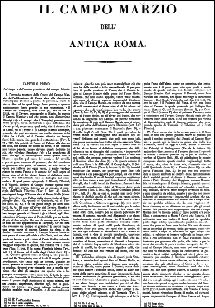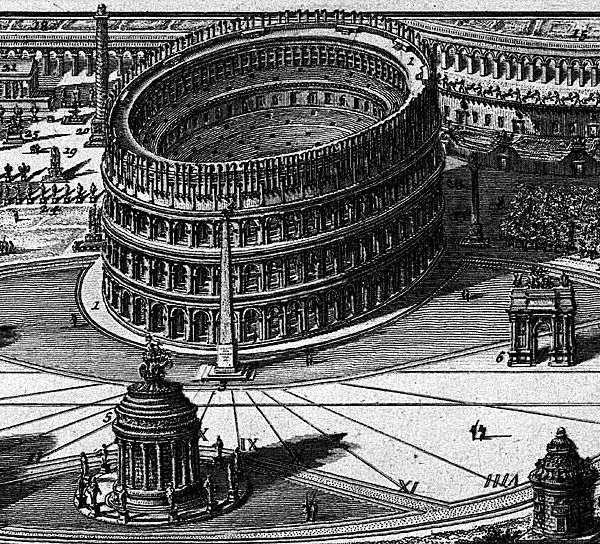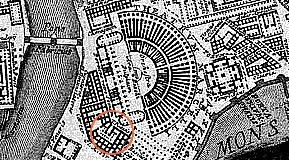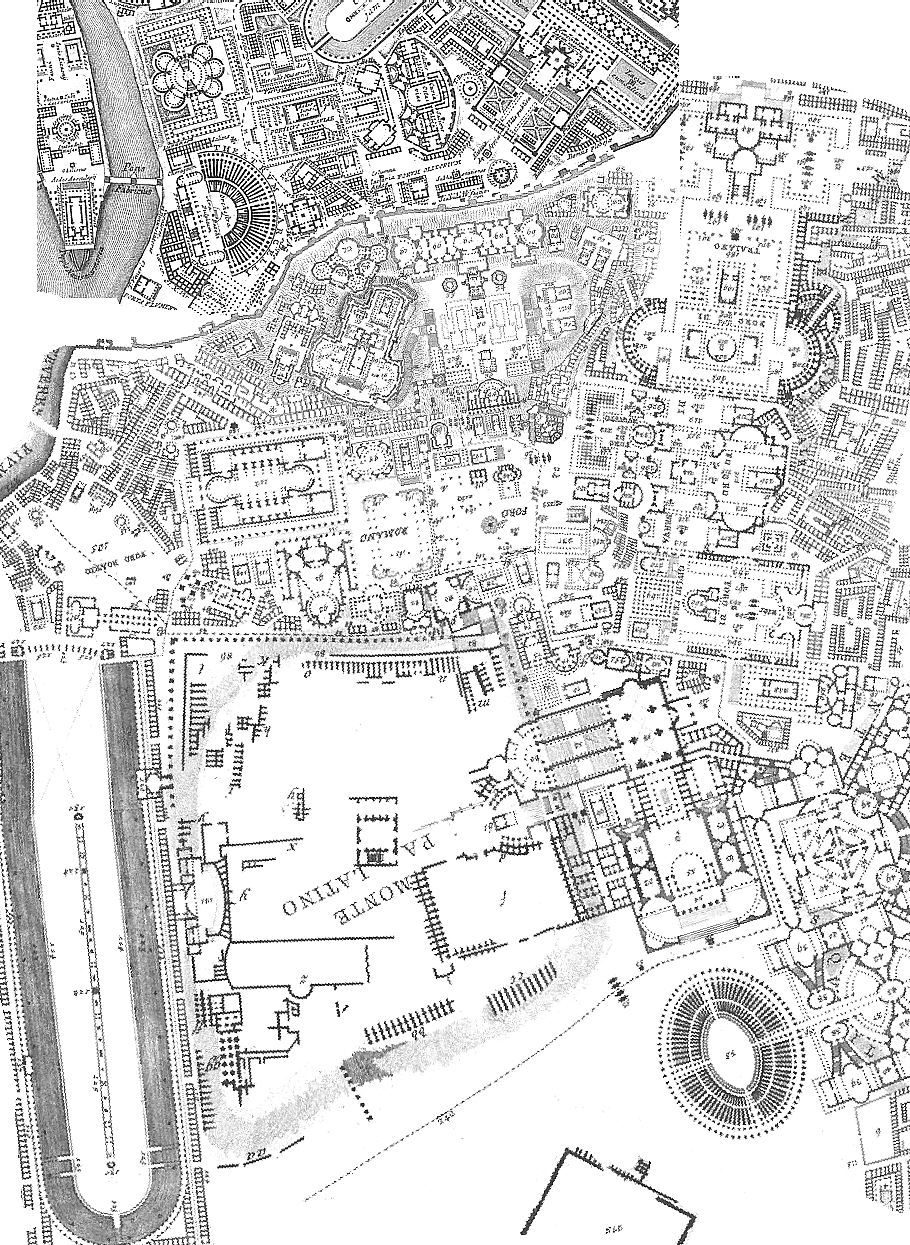The Campus Martius
The term campus Martius was used at different times with somewhat varying signification. In its widestsense it embraced the district outside the Servian wall between the Capitoline, the Quirinal, and the Pincian hills, and the Tiber This is a level plain, extending a little more than 2 kilometers from the Capitoline to the porta Flaminia, and being nearly 2 kilometers wide in its widest part between the Quirinal and the river. At least as early as the fifth century B. C. the south portion of this district was known as the prata Flaminia, and campus Martius was the ordinary designation for what lay beyond. After Augustus had divided the city into fourteen regions, the name campus Martius was restricted to that portion of region IX (circus Flaminius) which was west of the via Lata, the modern Corso, and here again there seems to have been a further distinction. A cippus found in the via del Seminario, near the Pantheon, proves that this campus Martius of the time of Augustus was divided into two parts, -- the open meadow to the north, and the district between the cippus and the circus Flaminius, which had been more or less built over. A little later this line of separation was marked by a street (called by Lanciani the via Recta), which ran west from the modern piazza Colonna to the Tiber. The original pavement of this street has been uncovered for most of this distance, and its line corresponds in general with the modern via di S. Agostino and via dei Coroiiari.
There were several swamps and ponds in this low-lying district, as well as streams, the largest of which, the Petronia amnis, came from a spring on the Quininal, anlled the Cati fons, and flowed into the largest swamp, the palus Caprae, or Capreae, where were afterward the pool and baths of Agrippa. In the northwest part of the campus martius, near the great bend of the river, there were hot springs, probably sulphurous, and other traces of volcanic action. This part was called the Tarentum, or sometimes campus Ignifer.
The name campus Martius was derived from an ancient alter of Mars, ascribed by tradition to Romulus, which probably stood about halfway between the baths of Agrippa and the Arx. The whole district belonging to the community, part of it being cultivated as domain land. We are told that Sulla, under the finacial pressure of the impending war with Mithridates, was the first to sell to private owners any part of this public domain; but the very name, prata Flaminia, which is quoted as early as 449 B.C., seems to indicate some private ownership at a very early date. It is probable, however, that these prata had become public property but retained their original name. The campus Martius was entirely outside the pomerium during the republic and probably down to the reign of Claudius. By the time of Hadrian the pomerium had been extented so as to include the prata Flaminia; but the campus martius in its narrower sense, was not included until the wall of Aurelian was built. Because it was public domain and outside the pomerium, the campus was used as a place of assembly for the citizens, in their military capacity as an army and in their civil capacity as the comitia centuriata. Audience was given here by the senate to foreign ambassadors who could not enter the city, and foreign cults were allowed to be domiciled in temples erected here. Finally public buildings of all sorts were built in the south half of the campus, while private houses did not begin to multiply to any extent before the time of the empire.
Besides those already mentioned, other parts of this extensive district bore distinctive names. The forum Holitorium, or vegetable market, was just outside the Servian wall, close to the Tiber. Between the modern ponte Garibaldi and the theater of Pompeius was a grove called the Aeculetum, where the comitia met in 287 B.C. to pass the famous Hortensian laws. Fragments of the pavement of the vicus Aesuleti have been found int he modern via della Regola di S. Bartolommeo. The suburb that in process of time extended from the porta Flumentana along the bank ofthe river to the Navalia, was known as extra portam Flumentanam; and within the limits of this precinct there had been, as late as the Gallic invasion, a grove called lucus Petelinus. Another suburb, the Aemiliana, is more difficult to locate with certainty, but it was probably the district between the porta Fontinalis and the Saepta Julia. The trigarium, where horses were exercised, was in the northwest part of the campus, between the modern piazza Navona and the Tiber. Just east of this Trigarium was probaply the place where chariot races, equiria, were held in honor of Mars, although this race course may have been further north. On the bank of the river, not far south of the mausoleum of Augustus, were storehouses for wine; and, to judge from the somewhat uncertain evidence, this part seems to have been called Cicconiae nixae, apparently from some statue standing there.
Besides the three principal streets in the campus Martius, -- the via Lata, the via Tecta, and the so-called via Recta, -- fragment of the pavement of some others have been found. One of them ran southwest from the theater of Pompeius tothe river, along the line of the modern via dei Pettinari; another ran north from this theater along the via dei Sediari; a third extended from the theater of Balbus to a point near the Tarentum, where it joined the via Tecta, its course being nearly that of the via S. Paolina, vicolo dei Venti, and via del Montserrato. The pavement of the fourth lies in a line between the via degli Astalli and the Corso, and may be that of the vicus Pallacinae, which derived its name from the balineae Pallacinae near the circus Flaminius. Another stretch of pavement has been discovered just north of the thermae Alexandrineae, in the via di Ripetta; and there are also traces of two cross-streets between the via Flaminia and the Tiber, one north (via dei Pontefici) and the other south of the mausoleum of Augustus. In 216 B.C. there was a via Fornicata, quae ad campum erat, but this street is mentioned only once. (Platner)
The Campus Martius or Campus Tiberinus was originally a great grassy and marshy plain bordered by a loop of the Tiber, outside the Servian wall, to the north-west of the Capitoline Hill. On the north-east it was bounded, roughly speaking, by the Pinician and Quirinal Hills; on the south by the Capitoline Hill and by the Tiber; and on the west by the Tiber. Being outside the Servian line of wall, and for long being marshy and exposed to floods, it remained unencumbered with private houses, and so, in later times, when a complete system of cloacae had got rid of its marshes, its great area was free for the erection of the most extensive and magnificent groups of public buildings in Rome.
Under the Empire almost the whole of this great plain, measuring roughly about one mile by three-quarters of a mile, was covered with a succession of sumptuous buildings, temples, theaters, circi, porticus, and thermae, forming one uninterrupted group of stately public buildings. In the Imperial period four or five bridges connected the Campus Martius with the opposite side of the Tiber.
The southern portion of the Campus, which formed the 9th Regio of Augustus, was called after the Circus Flaminius. The northern part was called the Campus Martius proper; and the eastern part took the name from the Via Lati.
In the time of the mythical kings of Rome the Campus Martius was a place of meeting for general assemblies of the citizens, for reviews of the army, and for various sacred games and festivals, such as the Equiria, was fabled to have been instituted by Romulus in honor of Mars, to whom the whole Campus was dedicated. The Ludi Saeculares and the Ludi Apollinares were held there.
The Campus also contains altars to Mars and to the Chthonian deities Dis and Proserpina. A great part of its area consisted of arable land and pasture, which the Tarquins are said to have treated as their private property.
Hence the older name of the Campus Martius, before it was consecrated to Mars, is said to have been Ager Tarquiniorum. Livy (ii.5), writing of the time soon after the expulsion of the Tarquins, says Ager Tarquiniorum qui inter Urbem ac Tiberim fuit, consecratus Marti Martius deinde Campus fuit: see also Livy, 1. 44, and vi. 20.
Under the Republic the Campus was almost wholly treated as public ground, and was used as a military and athletic exercising place, and for meetings of the Comotia Centuriata which were first held in the open air, and afterward in a great roofed hall built by Julius Caesar (the Septa Julia).
[Other] buildings in the Campus [included] theaters, such as those of Balbus, Marcellus, and Pompey, [as well as] the Thermae of Agrippa and Nero.
J. Henry Middleton, The Remains of Ancient Rome (London: Adam and Charles Black, 1892), pp. 195-7.
1956
Vincenzo Fasolo, "The Campo Marzio of G. B. Piranesi".
2691a
1995.01.07
Campo Marzio - encyclopedia reference
from Encyclopedia Britannica (19-572d):
Circus Flaminius - Beyond the point, occupying the low-laying ground in the bend of the river, lay the districts of the Circus Flaminius and the Campus Martius. The former area took its name from the stadium that was built in 220 BC on the site later occupied by the medieval ghetto. The principal Roman buildings still visible are the entrance to the Porticus Octaviae and the temples of the Largo Argentina. The former, a porticoed enclosure with a public library, was built by Augustus' sister Octavia, replacing an earlier building, the Porticus Metelli of 146 BC. Within it stood temples of Jupiter and of Juno. The entrance is a Severan restoration (AD 203). The sacred area of the Largo Argentina, excavated between 1926 and 1929, consists of a group of four small temples, three rectangular and one circular, which in their present form date from the 2nd and 1st centuries BC and which survived with only minor alterations throughout the Imperial period. The dedications are not known. Behind them, to the west, lay the Thearter of Pompey, the first permanent theater in Rome (55 BC), considerable remains of which survive incorporated in the houses to the east of the Campo dei Fiori. Scanty traces of the Augustine Theater of Balbus (13 BC) have been identified beneath the Palazzo Mettei de Paganica.
Campus Martius - The Campus Martius, though public property from a very early daye, was still open and in places swampy ground right down to the time of Augustus, when it was drained and laid out as a new monumental quarter by Agrippa (d. 12 BC). Though few of the actual Agrippian building survived the fire of AD 80, the quarter retained its monumental character throughout antiquity. In the Middle Ages, when the inhabited center of the city shifted to the lower ground by the river, most of the Roman buildings were destroyed. The principal surviving monument is the Pantheon...
Adjoining the Pantheon were Agrippa's Baths, the first of the great public bath buildings of Rome. Surviving buildings in the Campus Martius include the shattered drum of the Mausoleum of Augustusand, re-erected beside it, the Ara Pacia (13-9 BC) which stood besides the Via Flaminia at the corner of the modern Via in Lucina. The Column of Marcus Aurelius (dedicated AD 193) stands in the Piaza Colonna; it was modeled on Trajan's column and depicts the emperor's Danubian campaign. Much of the Temple of Hadrian can be seen incorporated into the Borso, the stock exchange, and on the opposite bank of the Tiber is the Mausoleum of Hadrian, converted in the Middle Ages into the fortress of Castel S. Angelo. Much of the Egyptian sculpture in the Vatican and other museums and several of the smaller Egyptian obilisks came from the destroyed sanctuary of Isis and Sarapis near the Collegio Romano, and the obilisk now in the Piazza Monticitoris was the pointer of the monumental sundail erected by Augustus near the Ara Pacia. The piazza Navona preserves the shape and much of the structure of the Circus of Domitian.
Wholly or partly surviving Roman bridges are the Pons Fabricius (62 BC), the Pons Aelius, now Ponte S. Angelo (AD 134), the fragmentary Pons Aemilius, or Ponte Rotto (179-142 BC), and some distance upstream the Pons Milirius (109 B.C.).
1998.04.12
Ara Martis
...significance of the Templum and Ara Martis that is situated next to the Circus Agonalis. ...this altar and temple to Mars are representative of the very original altar to Mars from which the entire campus Martius receives its name--indeed this altar is the very first "structure" of the campus.
...now knowing the program of the Alexander Severus complex. ...the porticus providing shade from the heat of the day. ...the temple and altar of Mars is surrounded by a very generous public amenity.
1998.07.12
Campus Martius
- the Field of Mars
- a place of assembly for the Roman people at the comitia centuriata; also, much resorted to by the Romans for games, exercise, and recreation, a place for military drills, etc.
Within his archeological publication Il Campo Marzio dell'Antica Roma, Piranesi wrote a history of the Campus Martius. The text, which is written in six chapters and supplemented with extensive footnotes, is both factual and polemical, and, for the most part, relates directly to the various maps and perspectives within the same publication. (The Ichnographia comprises six of Il Campo Marzio dell'Antica Roma's forty-nine plates.) The history itself is based on numerous ancient texts, as well as some Renaissance texts. It is interesting to note, moreover, that 20th century archeology, even though many more physical remains within the Campo Marzio are now unearthed, still relies heavily on the same ancient texts. It thus becomes arguable whether Piranesi's text is due more archeological credit than it generally receives.
The Il Campo Marzio text is written in Italian, and presently no English translation exists.

The first page of Piranesi's history of the Campo Marzio.
1998.07.23
Mars (Martis)
Palus Caprae 283b
2013.08.22 10:57
22 August
...the "archeological accuracy" section (which is now entitled "Archeological Mask or Reconstructive Surgery"). ...Piranesi was perhaps giving the Campo Marzio a "face-lift," a second chance where the "faults" have been eliminated and the dormant potential fulfilled. 3304n
| |
2013.12.24 19:05
24 December

There are many instances where buildings delineated within the Ichnographia Campus Martius are presented together yet actually never existed at the same time. For example, the Amphitheatrum Statilii Tauri burned in the great fire of 64 A.D., and the Columna apotheoseos Antonini Pii (depicted just right of the amphitheater) was erected in 162, and the Columna Cochlidos (depicted left and just behind the amphitheater) was erected in 192.
Similarly, the T[emplum] Pietatis and the Theatrum Marcelli are delineated together within the Ichnographia, yet the temple of Pietas was destroyed by Augustus in order to make room for the theater of Marcellus.
| |

|
Of more interest, however, is that Piranesi also omitted buildings that should have been delineated within the Ichnographia. While the Sepulchrum Honorij Imp., the mausoleum built by the emperor Honorius circa 400, is within the Ichnographia, the building that the mausoleum was in actuality attached to, the basilica of St. Peter built by the emperor Constantine circa 330, is not delineated within the Ichnographia.
| |

|
To: James Adam
From: Robert Adam
Date: 13 September 1755
[I] got [Piranesi] to finish the whole of Rome and to publish it alone without joining it in a book whose principal dedication was to my Lord Charlemont, which made mine less regarded, whereas mine being sold separate all the world will purchase it and have no other name to detract from the honour of the intention.
Within the first volume of Le Antichitŕ Romane are a series of plans of ancient Rome: baths of Titus, topographical map, barracks of Tiberius, baths of Caracalla, nymphaeum of Nero, baths of Diocletian, Forum Romanum, Capitoline Hill. When combined with the Ichnographia Campus Martius these plans constitute an almost complete plan of ancient Rome.

|




